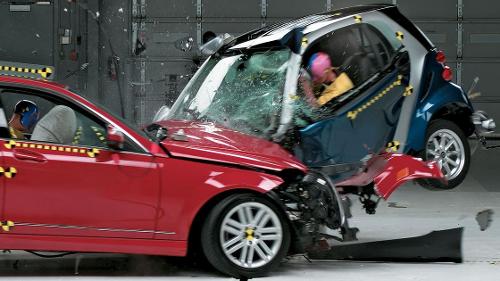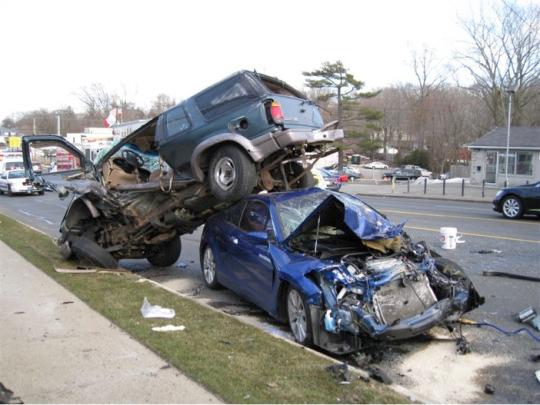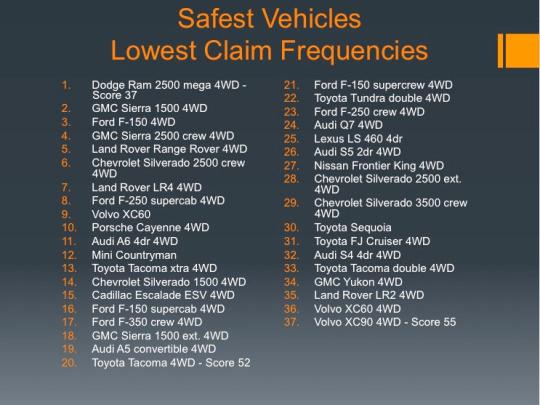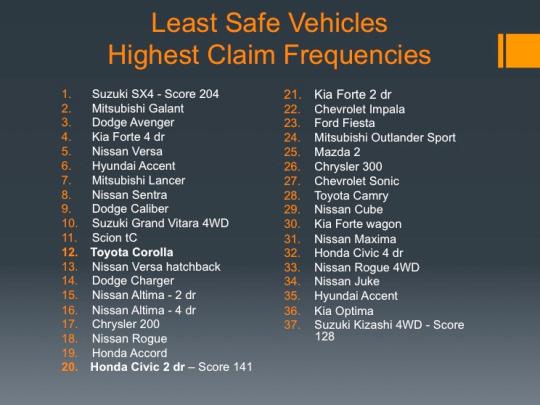How The Size Of Your Wallet Protects You In A Car Crash

When a Cadillac Escalade and a Honda Civic collide head-on, you don’t need a degree in physics to understand that the Escalade is probably going to win. But new research finds the extent of the Escalade’s advantage isn’t just its physical size, but its more massive sticker price.
A new study by the University of Buffalo found a correlation between accidents in which personal injury claims are filed and the size and price of the vehicles involved. In other words, more people get hurt in small, cheap cars than big, expensive ones — and the money matters a lot.
“We found that vehicle type, curb weight and price are all significant predictors of personal injury cost,” said Dietrich Jehle, a professor of medicine and biomedical research at the University of Buffalo. “For every additional $10,000 you spend, injuries go down by almost 12 percent. We also found that for every 1,000-pound increase in weight, vehicles were 19 percent safer.”
The study draws its conclusions based on the frequency of medical claims in collisions involving 360 different 2010–2012 car and truck models, ranging from the Smart ForTwo microcar to heavy-duty 4x4 pickups. It paints a different picture of automobile safety than one might see by relying solely on government crash-test scores, which generally involve single collisions of cars with various barriers. In order to make the data as clean as possible, the study used data collected in states that had no-fault insurance policies and adjusted for driver age and other factors; it also excluded sports cars due to their lower daily use.

Photo: University of Buffalo
The UB study makes some valid, if obvious, points: When two or more vehicles collide, heavier vehicles tend to push lighter ones around. The increased change in velocity for the lighter car in turn increases the risk of injury for those inside. “Overall, size is very important, but 32 percent of the variability is weight,” said Jehle. “The other thing is recoil…When smaller cars hit a larger, moving vehicle, that change in velocity can force the smaller car to go into reverse, resulting in far more serious injuries to the driver and passenger.”
Larger, heavier cars also generally surround the occupants with more protective materials and/or more space between the occupant and the parts of the car their bodies may encounter in a collision. “With a bigger vehicle, you have a larger crush zone,” said Jehle.

Then there’s the matter of vehicle interaction: SUVs and 4x4 pickups “tend to override smaller vehicles,” says Jehle, something that can be attributed not only to weight but bumper height and a higher center of gravity, making it more likely that the taller vehicle may impact smaller vehicles in more vulnerable locations within the structure. This is especially true if, at the time of collision, the smaller vehicle is “diving” under hard braking, which pitches the front bumper toward the ground.
What about price-dependent metrics? “More expensive cars are typically safer in a crash due to the greater weight of the higher value vehicles, the presence of more sophisticated safety features and the fact that SUVs, which tend to be the safest vehicles on the road, are priced higher than the average passenger vehicle,” Jehle said. “In our study, we found that nearly one-third of this increased safety is due to the greater weight of the vehicle and 11 percent is a result of the type of vehicle driven such as an SUV versus a sub-compact. Sophisticated safety features can explain much of the remaining benefits.”

Performing particularly poorly were some very popular models, including the Honda Accord and Toyota Corolla, both among the 20 least-safe vehicles, according to the study. There are some exceptions to the rule, with certain small or inexpensive cars such as the Volkswagen Golf and Subaru Outback performing 25 percent better than average, and the Jeep Wrangler performing 40 percent better than average. The Mini Cooper Countryman did so well (more than 50 percent better than average) that it placed 12th on the list of safest cars, according to the study, beating the Cadillac Escalade ESV and the 4x4 Ford F-350 crew cab.
Is there any good news for drivers who can’t afford, say, a pricey new luxury SUV but who nonetheless would like a safe new set of wheels? For one thing, many of the sophisticated safety systems that Dr. Jehle mentioned (knee airbags, camera- and sensor-based electronic safety aids, collision mitigation systems, et al) have been trickling down into smaller, cheaper cars at a much greater rate. For example, the new Scion iA (itself a thinly disguised Mazda 2) features a standard forward collision mitigation system with automatic braking, and the humble Subaru Impreza offers three levels of forward collision mitigation.
The other positive development has been more robust safety ratings. Ever since the Insurance Institute of Highway Safety (IIHS) started commenced a brutal small overlap crash test (which measures the crashworthiness of a vehicle traveling at 40 miles per hour into a fixed object, with only 25 percent of its front bumper striking the barrier), manufacturers of small cars in particular have started beefing up the crash structures affected in such an impact. Also, the addition of nuanced ratings such as the IIHS’ “Top Safety Pick+” which takes into account the availability of electronic safety aids, has prompted more and more carmakers to offer such systems on products all the way down their respective food chain.
Our advice, then, when searching for your next ride? If you can’t depend on protection from your checkbook, at least check all the safety boxes. If you’re lucky, you’ll never find out just how much they’re worth.




